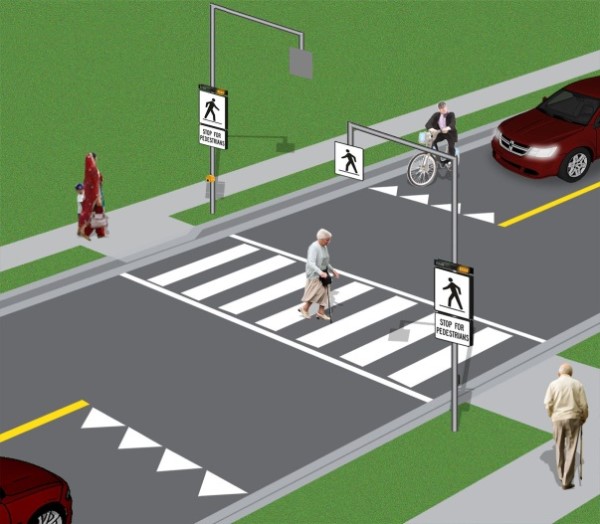Pedestrian Crossover
Pedestrian crossovers provide a safe place to cross a busy street.
Rules of Use
Drivers, including cyclists, must yield the entire width of the roadway and wait for pedestrians to clear the road.
Drivers are legally required to stop regardless of whether or not the pedestrian crossover location has a flashing beacon.
Pedestrians must only cross when it is safe to do so.
Stopping at a pedestrian crossover helps protect lives. Drivers failing to yield at a pedestrian crossover can face a fine of up to $1,000 and 4 demerit points.

Pedestrian Crossover Benefits
Pedestrian Crossovers have a number of benefits, including:
- Improved Safety: Pedestrian crossovers enhance safety by providing designated areas for pedestrians to cross roads. This helps reduce collisions involving pedestrians and drivers, as drivers are more likely to be aware of and yield to pedestrians in these marked areas.
- Accessibility: Pedestrian crossovers make streets more accessible for individuals with disabilities, including those using wheelchairs, walkers, or other mobility aids. They feature curb cuts and tactile indicators to assist blind or low vision pedestrians in navigating safely.
- Encourages Walking and Active Transportation: By providing safe and convenient crossing points, pedestrian crossovers encourage walking and other forms of active transportation. This can contribute to improved personal health by promoting physical activity and reducing reliance on automobiles.
- Community Connectivity: Pedestrian crossovers help connect different parts of a community, facilitating pedestrian access to schools, parks, businesses, public transportation, and other amenities. This fosters a sense of community and promotes social interaction.
- Traffic Calming: Pedestrian crossovers can serve as a form of traffic calming by prompting drivers to slow down and be more cautious in areas with high pedestrian activity. This can help reduce vehicle speeds and create a safer environment for all road users.
- Environmental Benefits: Encouraging walking and active transportation through pedestrian crossovers can help reduce greenhouse gas emissions and air pollution associated with motor vehicle use. This aligns with sustainability goals and contributes to a healthier environment.
Contact Us
The Municipality of South Huron
322 Main Street South, P.O. Box 759
Exeter, ON N0M 1S6
Phone: 519-235-0310
Sign up to receive municipal news to your email inbox
